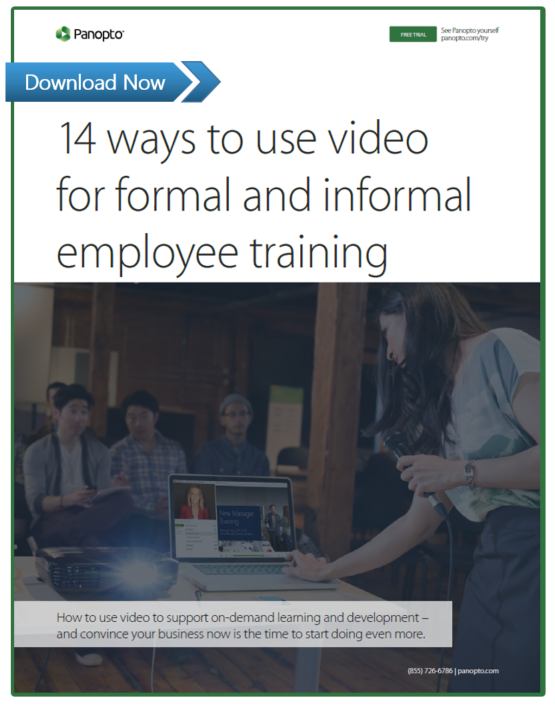- Enterprise IT/AV
How to Make Continuing Education For Employees a Continuous Priority
Organizations perform their best when their people are in a growth state. A dynamic company attracts and retains professionals committed to developing their own careers in a way that can be born out of their work.
All too often, even the best hires can put their professional development on the backburner under the stress of the day-to-day. If continuous learning isn’t a priority, meeting continuing education deadlines and requirements can start to feel like playing whack-a- mole — an exercise in cramming the easiest to obtain knowledge into an employee’s head at the very last minute.
mole — an exercise in cramming the easiest to obtain knowledge into an employee’s head at the very last minute.
Even worse, if an individual’s current job activities are getting in the way of his or her career development, you might find your top performers leaving your company in order to pursue the learning they need elsewhere.
In order to keep your organization growing, your employees need opportunities to learn and grow too. So how do leading enterprises support their employees in developing their own careers?
It’s Called Professional Development — But It Better Be Personal
When it comes to encouraging employees to care about their own professional development, there’s no substitute for ensuring that they perceive that learning is relevant to them in the moment. Focusing on the individual is the first and most critical step in ensuring that he or she perceives their professional development as both important and urgent, and acts accordingly.
Every employee in your organization will always feel as though they are at a unique place in their own career, and even employees with similar job functions can have different skills and long-term career goals. The truth is that you’ll never truly know your employees’ goals unless you ask them, and you’ll never truly be able to support their professional development unless your training is aligned with those goals.
From Manager to Coach: Enabling Your Company’s Leaders to Support Employee Development
Your organization’s managers will have an enormous impact on your employees’ development, either to positive or negative effect. It’s their job to ensure that they are helping their reports meet their individual goals, and it’s the learning and development team’s job to ensure that managers have the tools they need to do that.
When it’s well done, manager feedback will be informative and build employee confidence. But one-and-done annual reviews inspire fear or rely too heavily on the promise of outside incentives like bonuses to affect change.
In order to create a culture of mentorship within your corporate hierarchy, proactive manager feedback in conjunction within individual goal-setting, should be a frequent and familiar occurrence.
Documenting both goals and feedback at every step along the way, especially in a rich format with audio and video, will help ensure that individuals and their managers can have productive, supportive conversations that build on each other from year to year.
Build a Culture of Learning from Day One
In the first few days, weeks and months in a new job, employees are focused on making a good first impression, but this period is just as important for your organization to prove its dedication to them and their development. Onboarding is a time when employees will learn more about your organization that at any other time. They are listening as much to how you share information with them as much as to what information you are actually trying to convey. The way in which you approach learning at the beginning will set the stage for the months and years to come.
Since employee onboarding tends to focus on company mission, policies and other information that isn’t directly tied to an employee’s specific job function, it can be tempting to think that it really isn’t related to professional development. But, especially since the onboarding process makes up a large piece of their first impression of your organization, employees will look at the ways your corporate learning and development team operates, and judge all of its activities accordingly.
Along with goal setting, personalized learning can and should be a part of the onboarding process. While some content, like compliance training and emergency preparedness, will need to be the same for everyone, strive to identify ways to respect each individual’s unique experience, attitudes and skill set.
Switching to video-based eLearning for employee onboarding is a great way to make mass customization a reality. By moving away from classroom-based group training and instead delivering critical information through video, your organization can scale up the diversity in its training materials to better support professionals with varying needs. When done right, video training can leverage the benefits of one-on-one training that might otherwise be cost prohibitive.
Make Learning Work for Your Employees, Instead of Interrupting Them
The principles of informal learning suggest that the vast majority of learning — around 70% — doesn’t happen through formal training courses, but instead through action. Employees instinctively sense this, every time a training is forced on them. Even if it’s relevant to their career goals, training that doesn’t relate to their current job responsibilities is overwhelmingly lost in the fray of the everyday.
Far from representing the end of formal training, informal learning tenants suggest a way forward for supporting employees in their professional training with a centralized and manageable library of on-demand content. When learning must be done through doing, training materials can be made available exactly when it’s needed to help individuals more quickly uncover solutions to sticky job problems.
By making training content available on video, accessible from anywhere at any time, the training syllabus no longer dictates what an individual must complete. For any given employee, there may very well be content that is never used, while other content might be reviewed again and again.
In this model, employees “pull down” the information they need, putting them in charge of their professional development when and where they need it. By allowing employees to dictate what they learn based on the needs of their job, you can ensure they’re getting the right training with the least frustration.
Related Reading: How To Help Employees Make Time For Learning
Enable Employees to Share What They Know — and What They’re Learning — With One Another
While manager feedback is critical for successful professional development, so too is interaction between employees both within and between departments. Just because learning activities are moving away from the classroom doesn’t mean that they’re becoming more solitary. In fact, social learning as a managed organizational practice is on the rise, and video is making it possible.
In many ways, sharing knowledge with others can offer many of the same benefits as actually doing the task itself. Visionary organizations acknowledge the benefit that employees have to offer to the professional development of others and empower them to support one another. Through journaling challenges and sharing best practices with one another, employees can support both their own development as well as that of their colleagues.
Watch an example social learning video below:
Keep Continuing Education Challenging
Just as important to keeping employees engaged in their development as making it relevant is ensuring that they’re always challenged. Making relevant development material available at any time, is a great way to get employees comfortable and engaged with the development process. For your top performers, those who have been with your company a long time, or those that already have a great deal of experience, having access to a deep library of video training content is a great way to ensure that they’re never bored.
Even for managers and other people high in your organization’s hierarchy, training materials can be a great way to keep people engaged in their jobs, even when the pool of mentors inside your organization starts to shrink.
Goal Set and Achieve
Corporate learning and development professionals are beginning to see the opportunity that video presents in helping their employees set goals, achieve job-relevant training, share what they’ve learned with others and stay challenged. With an ever-expanding library of content created both from the top-down and from the bottom-up, employee training can be more flexible and robust than any classroom, more personalized and attuned to individual goals.
Find Out More About Supporting Continuous Learning With Video
 In our complete white paper, 14 Ways to Use Video for Formal and Informal Learning, we help L&D practitioners make the business case for doing more with video.
In our complete white paper, 14 Ways to Use Video for Formal and Informal Learning, we help L&D practitioners make the business case for doing more with video.
In it, you’ll learn about the 5 benefits that help convince your decision makers to use video in more ways for L&D, 14 ideas for supporting and scaling formal and informal learning with video, and 1 technology — the video platform — that simplifies the use of video for learning.




